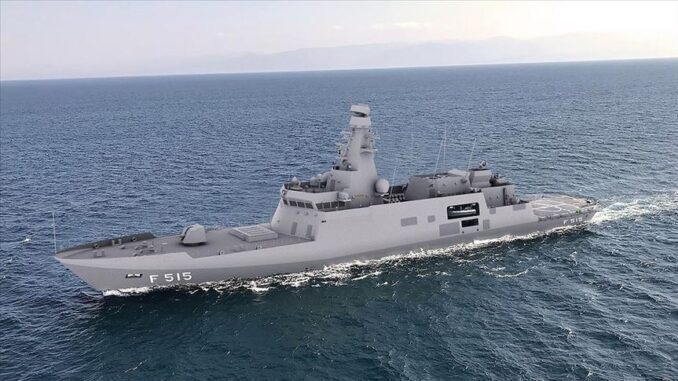
Steel-cutting ceremony was held in Karachi to build state-of-art MILGEM Ada class corvette by Turkey for Pakistan Navy
The steel-cutting or the ground-breaking ceremony to begin construction of the MILGEM Ada class corvette by Turkey for Pakistan was held in the southern port city of Karachi, the Pakistan Navy said on Tuesday.
The ceremony at the Karachi Shipyard and Engineering Works (KSEW) — Pakistan Navy’s specialized shipbuilding division — was attended by officials of Pakistan Navy, and representatives of Turkey’s state-run defense firm ASFAT, including Managing Director of KSEW, Rear Admiral Ather Saleem.
In July 2018, Pakistan Navy signed a contract for the acquisition of four MILGEM-class ships with the ASFAT. According to the plan, two corvettes will be built in Turkey and the next two will be built in Pakistan which also involves technology transfer.
The keel-laying or the formal recognition of the start of the construction ceremony of the first MILGEM Ada class corvette was held in Istanbul last week.
MILGEM vessels are 99 meters long with a displacement capacity of 24,00 tons and can move at a speed of 29 nautical miles.
MILGEM anti-submarine combat frigates, which can be hidden from the radar, will further enhance the defense capability of the Pakistan Navy.
“The MILGEM Class Corvettes will be state-of-the-art surface platform equipped with the modern surface, subsurface and anti-air weapons, sensors, and combat management system. These ships will be among the most technologically advanced platforms of the Pakistan Navy and will significantly contribute to maintaining peace, stability, and balance of power in the Indian Ocean region,” the statement said.
Speaking at the ceremony, the General Manager Ship Building, Commodore Muhammad Jahanzeb Ahasn underscored the deep-rooted friendship between Turkey and Pakistan for collaboration in the field of indigenous warship construction and other defense sectors.
In October 2019, Turkey’s President Recep Tayyip Erdogan along with Pakistan Navy Chief Adm. Zafar Mahmood Abbasi had cut the first metal plate of the first MILGEM Ada class corvette during a ceremony in Istanbul.
Turkey is one of the 10 countries in the world which can build, design, and maintain warships using its national capabilities.
Bayraktar Akıncı Armed Drone
A documentary on Turkey’s newest armed drone was released on the first day of the Muslim Eid al-Fitr holiday revealed how Turkey’s cutting-edge Bayraktar Akıncı armed drone was developed.
The feature, titled “AKINCI” after the model’s name, documents the development of the unmanned combat aerial vehicle (UCAV) and was posted on the YouTube channel of arms maker Baykar Technologies on Sunday, 24 May 2020.
It was released at 8:23 p.m. local time (5:23 p.m. GMT), alluding to the country’s 100th foundation anniversary in 2023.
Baykar’s chief technology officer Selçuk Bayraktar posted two trailers of the documentary on his Twitter account over the past week.
“AKINCI,” directed by Altuğ Gültan and Burak Aksoy, was shot in 15 months in Baykar’s facilities in the Turkish metropolitan city of Istanbul and northwestern Tekirdağ province.
It covers a six-month period until Dec. 6, 2019, when the drone flew for the first time.
Bayraktar and the leaders of Baykar’s engineering teams narrate the efforts that led to the development of Turkey’s first hi-tech aircraft.
The Akıncı UCAV’s prototype PT-1 made its second flight on Jan. 10, while the second prototype PT-2’s integration has recently been completed.
The UCAV, which can fly for up to 24 hours, has a maximum altitude of 40,000 feet with a 20-meter (65-feet) wingspan and a load capacity of 1,350 kilograms (2,976 pounds).
Akıncı’s maximum takeoff weight is 5,500 kilograms (12,125 pounds). It has two 450-horsepower engines but can be equipped with 750-horsepower engines or locally made 240-horsepower engines.
With the Akıncı UCAV, Turkey will become one of the three countries capable of producing this drone class.
It will provide high flight security with its fully automatic flight control and triple-redundant auto-pilot systems.
Akıncı is equipped with a locally made AESA (active electronically scanned array) radar and Gökdoğan and Bozdoğan air-to-air missiles.
It can also launch several locally made ammunition, such as the SOM (standoff) cruise missile, for strategic targets. It can collect and store data from its sensors and cameras via six artificial intelligence (AI) computers.
Capable of detecting land targets that cannot be seen by human eyes, the drone flies not with a GPS, but its own systems.



